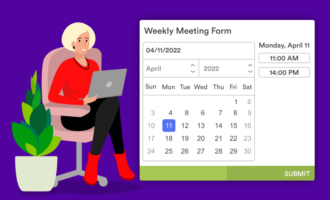Remote work is nothing new. Entrepreneurs with geographically distributed teams have been advocating for it for years. In fact, a 2017 study found that the average worker would accept 8% less pay for the option to #WFH — because employees too have long recognized the value of working remotely.
Still, no one imagined that so much of the workforce would be pushed to work remotely so suddenly.
“This is not how I envisioned the distributed work revolution taking hold,” wrote Matt Mullenweg, chief executive of Automattic, the software company that owns the WordPress blogging platform.
Anticipated or not, remote work is the reality for many of us — and that’s not necessarily a bad thing. As Jennifer Christie, Twitter’s head of human resources, told in BuzzFeed News”
“We’ll never probably be the same. People who were reticent to work remotely will find that they really thrive that way. Managers who didn’t think they could manage teams that were remote will have a different perspective. I do think we won’t go back.”
At my company Jotform, we were fortunate enough to have some preparation. With over 140 employees in three offices spanning two countries in vastly different time zones, we have experience with collaborating at a distance. Nonetheless, the pandemic has taught us some significant lessons.
The importance of communication
Writes Mike Walsh, CEO of Tomorrow, for Harvard Business Review:
“Centralized offices have one big advantage: you can get everyone in a room until they solve a problem. But when you work virtually, you have to plan every part of the decision-making process, especially when it is asynchronous.”
Without the advantage of in-person interactions, leaders have to be more meticulous about planning. That means ensuring that everyone is on the same page and that data and information are shared with decision-makers in a timely fashion. In a remote setting, team members must lean heavily on asynchronous communication — sending messages and information without expecting an immediate response.
More and more, I’m finding that mastering asynchronous communication is key to managing a remote team. And to be effective, it’s crucial to settle on communication tools to be utilized by your entire team.
Using common tools not only makes your employees’ lives easier and their collaborations more effective, but it can also increase their productivity. Research published in Harvard Business Review found that when one organization began mandating the use of common IT tools, employees who required approvals from their supervisors saw an additional 3% increase in productivity.
So, which tools should you use?

Here, a variety of tried-and-true tools that have worked for successful remote-only organizations and my team at JotForm.
1. Public threads
For many teams, Slack has become the standard communication tool. Convenient as it may be, it has its drawbacks, too.
Doist, a company with over 65 team members connected across 26 countries and 15 time zones, shared that “keeping up with Slack conversations began to take over more and more of our time. But when we looked for an alternative, the communication tools on the market followed the same synchronous chat model.”
So, what’s a startup to do? Doist created their own communication app called Twist — messages and threads that are organized by topic in public channels.
The team at Doist explained:
“Because they stay organized and searchable forever, threads are perfect for longer-term, more in-depth conversations.”
If you’re not ready to develop your own tool, try a ready-to-use software like — you guessed it, Threads. That’s what the team at Buffer uses to conduct asynchronous communication among their global, remote team members. They explain:
“As a company, we were looking for a calmer, more timezone-inclusive place for longer discussions to complement our Slack chatter. Threads has been the perfect spot to talk in-depth across many time zones, easily make decisions, and have a place where longer-form communication could live.”
When direct chats fall through the cracks, try giving your conversations a place to live on threads.
2. Blogs
It should come as little surprise that Matt Mullenweg, chief executive of the software company that owns WordPress, utilizes blogging for asynchronous communication with his team.
Writes Mullenweg:
“We use our own WordPress blogs, called P2, instead of email as our central hub of communication so people throughout the company can access every team’s long-form notes, documents, and priorities. We’re bloggers by heart, so we blog a lot.”
There are various benefits to using a blog to distribute information — it’s an easily sharable and searchable interface that requires zero training. Blogs are a smart way to post useful information for team members to consult anytime.
3. Online forms and PDFs
Without the ability to pop over to your colleague’s desk for feedback, the remote environment sometimes forces us to find new ways to review each other’s work.
PDFs are one tool that enables effective peer-to-peer review. In addition to preserving the original document, they’re simple to create and distribute.

At Jotform, we’ve been collaborating with our latest tool, Smart PDF Forms, to convert PDFs to online forms (no surprise there), which we use for both logistical purposes — e.g., to organize virtual meetings — and to track our users’ feedback.
The benefit of this new feature is that it allows us to collect information using fillable forms, but also retain the original layout in a fixed, PDF form. We can also track and check responses like a searchable database.
Like all of our forms, they’re customizable, too — zero developer skills required.
4. Decision logs
Wade Foster, CEO of Zapier, a remote-only company from the outset, thinks that not having a centralized office forces leaders to lead better. It just takes some planning and organization.
At Zapier, one of the ways they organize asynchronous communication is with a decision log called Async, where all major decisions are documented. As explained Harvard Business Review,
“The purpose of Async is to surface important conversations that might get lost in fast-paced Slack forums. It replaces internal email and acts as a searchable archive for anyone on the team to reference old discussions and keep up with company updates.”
Although Async was developed in-house, any form of public decision log, even a shareable Google Document, is a smart addition to your asynchronous communication channels.
5. Project management software
One of the trickiest parts of managing a remote team is coordinating projects, especially when they’re time-sensitive. There’s no bigger stressor or time suck than scrambling to track down various people’s progress on their respective parts.
It’s like juggling while blindfolded — juggling is hard enough.
Instead, teams can use a web-based tool like Trello, both for individual task management or project management for an entire team. Trello lets you assign tasks to individual team members or groups of team members, and, importantly, it tracks deadlines, too.
Think of using software like Trello as a visit to the virtual office — “When you need to see progress, at-a-glance status updates, and all relevant resources related to a project or team’s work.”
These days, there are tons of tools and software to choose from. The key to mastering distributed teamwork and asynchronous communication is to choose the best tools for your team’s needs and settle on the ground rules.
Says Beat Buhlmann, General Manager EMEA, Evernote:
“It is important to establish communication rules in a joint team-code-conduct manner that includes teams and their wishes directly in the creation.
When do we use chats? Why do we write emails? At what point do we pick up the phone? These answers should be a joint effort and one that is reflective of the team’s efforts versus that of one person.”
Which tools does your remote team use? Let me know in the comments.




































































Send Comment: